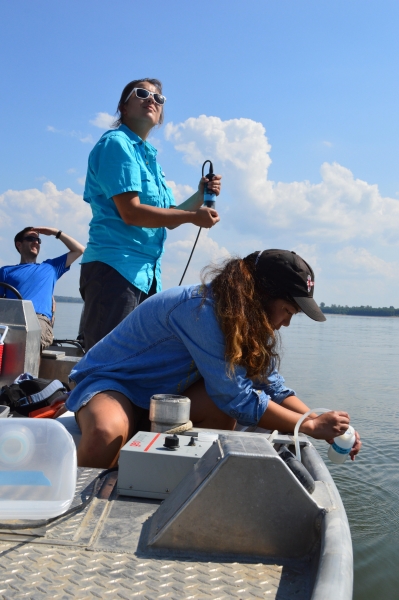By: Jeremy L. Conkle, Assistant Professor in the Department of Physical & Environmental Sciences at Texas A&M University-Corpus Christi (TAMUCC)
The growing tide of plastic debris in our ocean is partially due to the steady discharge of plastic by our rivers that drain into the sea. Plastics materials enter waterways from rural and urbanized areas located near riverbanks, and then travel downstream with the flow. Plastic comes in a variety of sizes and includes both macroplastics (large enough to be seen with the naked eye) and microplastics (not easily seen with the naked eye and are about 5 mm in size; about the size of a pencil eraser). While macroplastics generally result from littering and illegal dumping, most microplastics are created when those larger plastics, such as a plastic bottle, break down into smaller pieces over time and fragment or shed into hundreds of pieces as they move around the environment.
Clothes made out of polyester or other synthetic materials also shed plastic fibers. Some studies have shown that one piece of clothing made with these materials can shed thousands of fibers during a wash. These fibers then enter our wastewater stream, which is treated at a wastewater treatment plant, and are typically released into surface waters. Therefore, rivers that drain from large areas with higher populations, and generate large volumes of treated wastewater, are likely to have a higher concentration of microplastics in the water.

In the United States, the mighty Mississippi discharges 593,000 cubic feet of water per second, making it the largest river in the United States. Its basin, or the area of a river that collects water, spans 32 states, parts of Canada, and is home to about 90 million Americans that release their treated wastewater into the watershed or river directly. Therefore, the Mississippi River is likely transporting massive amounts of microplastics through some of the most productive fisheries habitats in the U.S. as it makes it way from the headwaters of Lake Itasca, Minnesota, all the way down to the Gulf of Mexico.
With funding from the NOAA Marine Debris Program, Texas A&M University-Corpus Christi examined the Mississippi Rivers microplastic load and its characteristics and discharge to the Gulf of Mexico. This collaboration between Texas A&M University-Corpus Christi, St. Louis University, Louisiana State University, and the University of Central Florida involved sampling the river at 11 sites. Of those sites, eight were in the greater St. Louis area, where three major tributaries merge with the Mississippi River, and three sites were in Louisiana prior to the river flowing into the Gulf of Mexico.

Examining our samples under the microscope, we found materials that looked like plastic in all of our samples. Fibers accounted for 96% of these materials, while other particles made up 4%. When these materials were more deeply analyzed, we determined that only 10% of the materials were fully plastic, while 65% were semi-synthetic, meaning they are made from materials that were a mix of natural and plastic materials. The most common fully plastic material we found was polyester, while the most common semi-synthetic material we found was a cotton blend, which had a varying amount of cotton, rayon, nylon, and spandex. All of these materials are heavily used in modern textiles, which indicates that much of the materials found may come from treated wastewater discharges.
We are still working through our results to calculate the amount and mass of each of these materials in the Mississippi River and expect to publish our results later this year. We have also started a similar study in all the major rivers and bays in Texas to develop estimates of the amount of microplastics discharged into the northwest Gulf of Mexico that come from over 50% of the U.S. land area and over 100 million people. Through this work, we hope to better understand the impact of microplastics on wildlife in the region, as well as better manage and improve water quality and ecosystem health of the Gulf.

blah